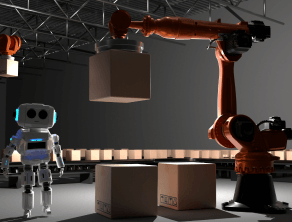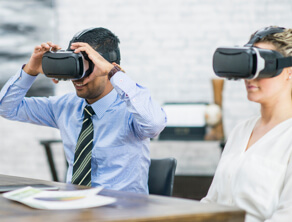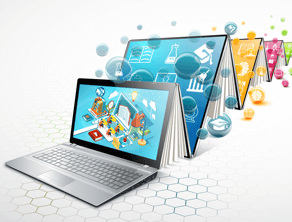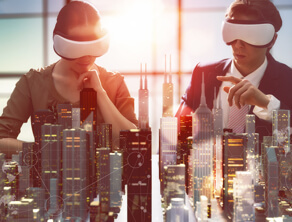The Applications of Virtual Reality in the Manufacturing Industry

What’s the first thought that crosses your mind when you think about VR in the manufacturing industry? Since manufacturing is arguably the most physically intensive business, and virtual reality is virtual, it sure sounds ridiculous.
But, on a serious note, the applications of virtual reality in the manufacturing sector are numerous. From the looks of it, it is only a matter of a few years before the manufacturing industry cannot function without the aid of VR.
In any case, implementing virtual reality applications has numerous advantages for the manufacturing sector. Typically, manufacturing facilities are enormous, intricate assemblages of diverse machinery that never stop. Even a small delay of one second can significantly impact the continuous flows and activities.
Testing, training, and maintenance are difficult to arrange under these circumstances since they frequently involve both a risk to the workers’ safety and a disruption of the manufacturing process. Much of the machinery used in production is hazardous and requires specialized training.
Here is where virtual reality truly shines. Manufacturing organizations can streamline their processes by transferring risky and challenging procedures to VR, which might even help them cut back costs.
In this article, we will go over the applications of virtual reality in the manufacturing industry.

Uses of Virtual Reality in the Manufacturing Industry
Floor Planning
Although floor planning is used throughout a wide range of sectors, not just manufacturing, it could be trickier and more challenging in this case. Planning the area for assembly lines or production workshops necessitates considering various elements, including the size of the equipment, connections between various components, safety distances, power outlets, supply line inputs, and many other things.
Virtual reality makes it considerably simpler to plan the production floors. The makers may check that everything is properly positioned and wired by building virtual recreations of the real locations and placing the equipment models.
They can check whether all equipment is easily accessible, all safety distances are maintained, and the production sequence is constructed in the proper order using virtual reality. Before physically shifting the equipment, businesses can optimize their floor space by using virtual reality in manufacturing.
Hence, virtual reality can assist in lowering labor expenses and reducing worker or equipment harm.
Engineering and Design
The prototyping step is usually always a part of the design process in manufacturing. The new product prototype is ready to be examined, tried, and tested before being determined to be ready for production or in need of some adjustment.
The prototype could be quite expensive to create if the product is a complicated piece of machinery. Additionally, the cost of the prototype can increase if it needs more refinement. Shifting the prototype to virtual reality can offer immense benefits. The overall expenses can be less than creating a line of physical prototypes, even after accounting for the cost of developing the virtual reality app.
Safe Training
A fantastic way to use virtual reality in manufacturing is for training. Many businesses use VR training, but the industrial sector gains the most from this technology. There are strict rules regarding the learners’ safety when training for an extremely dangerous career.
Such training is frequently challenging to plan because, for starters, the students lack practical knowledge, which increases their risk of harm. On the other hand, using simulators offers few options and ultimately cannot accurately simulate the nature of the job.
In this instance, virtual reality exhibits its exceptional capacity to immerse the trainees in a realistic setting while eliminating the chance of injury.
Maintenance and Inspection
We must acknowledge that virtual reality can effectively erase time and space if we consider industrial equipment inspection. Machines are getting too complicated today for typical production workers to inspect.
Companies frequently need to invite experts from the facility that produced the equipment for any normal or emergency examination. Such inspection visits are typically expensive and require meticulous forethought and timing.
Since inspectors’ schedules are sometimes occupied for weeks, it could be challenging to schedule an appointment when a machine unexpectedly breaks down. Additionally, the inviting party frequently pays for airfare and lodging.
The factory can avoid sending the inspector to the machine using virtual reality. Instead, it can quickly deliver the machine to the inspector. The manufacturer can inspect the equipment remotely without calling an expert by making a VR video of the apparatus.
Inspections and remote maintenance can be completed in virtual reality far more quickly and with fewer interruptions to the production cycle when travel time and costs are not factored into the calculation.

Business Events or Exhibitions
Heavy machinery manufacturers who present their products at trade shows and exhibits typically struggle to set up shop at the venue. The job is intricate and multifaceted. The maker must consider the machine’s shipping, connection, and use at the exposition.
A machine may require a large amount of space and weigh several tonnes, which results in additional expenses for the renting of the display area as well as for loading and unloading. Where to get the object to show is another issue that equipment manufacturers may find problematic. Heavy equipment is typically produced in response to requests and is not idle.
All of these issues can be resolved by virtual reality. Create a VR app that showcases your equipment, and you can downsize your exhibition space to a standard stand or booth. You may display machinery and equipment of any size and complexity in virtual reality. Additionally, by inviting exhibition visitors to your VR room, you may demonstrate the technology in action without endangering the guests.
Final Thoughts
As you can see, there are various ways that virtual reality is used in manufacturing, all of which have advantages. VR can be used as an extra test platform, a workshop, a conference room, or an exhibition stand because of its adaptability and virtually limitless options for constructing virtual places. Manufacturing could be safer, quicker, more precise, efficient, and less expensive thanks to virtual reality.
Today, virtual reality is being embraced by the manufacturing sector in various ways. We think that industrial businesses can gain a significant competitive edge and improve the safety and productivity of their everyday operations by using VR-based apps.
Tags: Manufacturing, VR
![Blog-[x]cube LABS](https://d6fiz9tmzg8gn.cloudfront.net/wp-content/uploads/2016/06/blog_banner.jpg)





